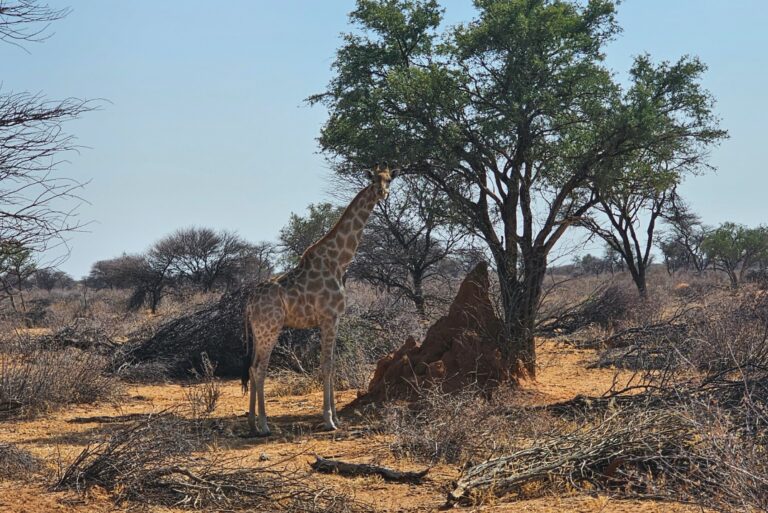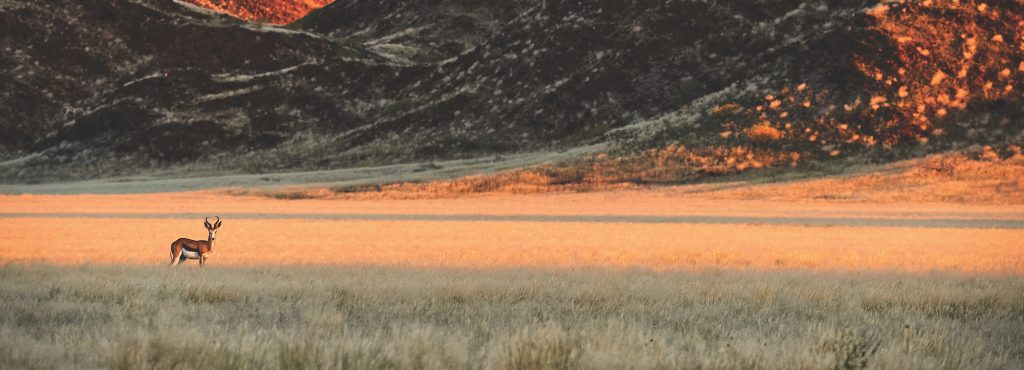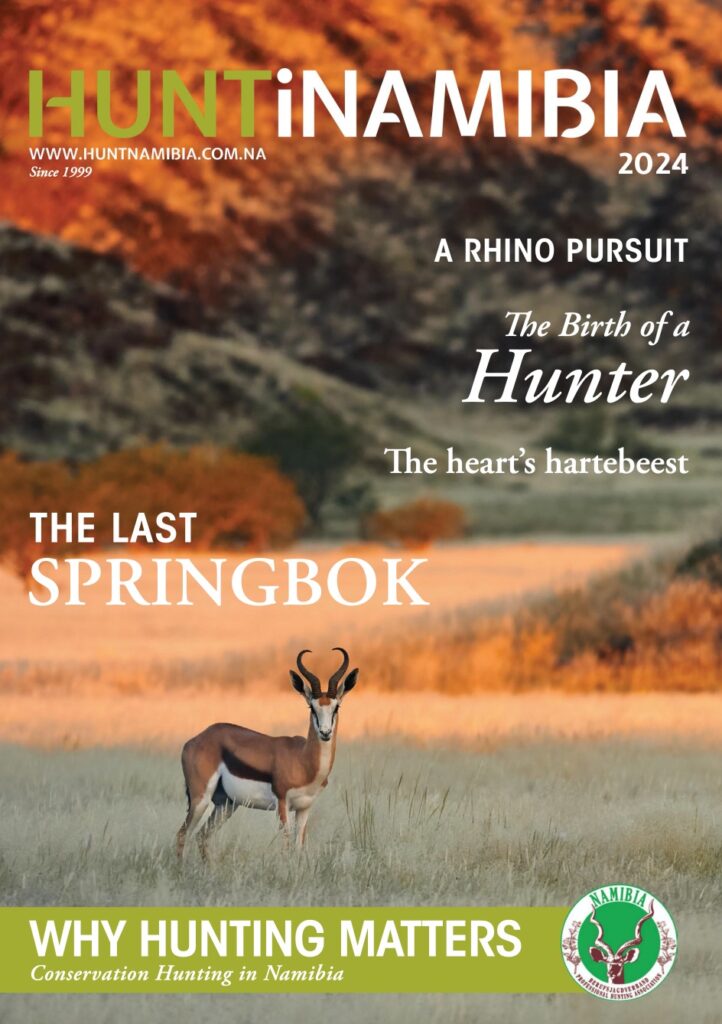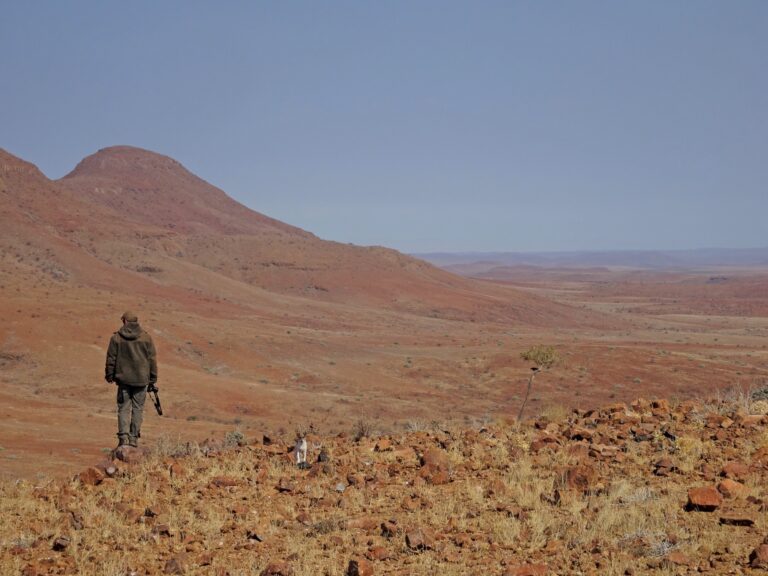This may not apply to all areas where this species occurs as springbok are distributed over large tracts of Namibia, Botswana and South Africa, and the terrain differs considerably, but it certainly applies to the barren open country of southern and western Namibia.
The springbok is my favourite game animal – for a few days of springbok hunting at the edge of the Namib Desert I postpone everything else. So much so, that if I would have to stop hunting except for one species, I would choose springbok. Now, while springbok certainly are not endangered, it has become apparent in a dramatic way to me that springbok country true to my heart’s desire – meaning vistas of endlessly far horizons in unspoiled, unfenced landscape – is disappearing.
When the Tsiseb Conservancy at the Brandberg in western Namibia was formed and registered 20 years ago, I was the first professional hunter there. Together with the manager, Eric Xaweb, I selected the spot for the hunting camp. Our considerations and motives were centred around choosing a spot in the heart of the core conservation area, away from the main tourist activity near Brandberg, yet with a splendid view of the mountain and, importantly, some shade, which we found under the camel thorn trees along the dry watercourse of the Xanamab River. Being in this plain camp amidst a scenery that is both desolate and empty and at the same time simply immense, has given me that perfect peace of mind that perhaps only the desert can give.
Moreover, in this conservancy I worked with the most reliable and dedicated community game guard I have ever met. Eric (Stanislaus) Ganaseb has been my right-hand man and friend for all these years, accompanying almost all my hunts in Tsiseb.
So, I was in high spirits when driving towards my lonely camp at the Xanamab River in February 2023 to prepare it for the first hunt of the season. Readers can perhaps imagine my alarm, when the unobtrusive track along the dry riverbed suddenly merged with a newly constructed gravel road coming in from the southeast. And my utter dismay when realising that this gravel road led right through the heart of the core conservation area, passing behind the hunting camp, and that lorries were driving hence and forth day and night, roaring, rattling and clattering.
I expressed my concern to the Conservancy Management Committee and there learned that a Chinese mining company had established lithium mines in the area and that moreover a Green Hydrogen Scheme was planned to the west of Brandberg Mountain with a string of wind turbines running along the foot of the mountain towards Uis. The first phase of the project was to be implemented at the end of March.
After setting up the camp in a very anxious mood I drove to Windhoek to pick up the client at Hosea Kutako International Airport, returning to my camp in Tsiseb Conservancy late on a Sunday evening.
All was silent and at our small flickering campfire we were able to enjoy the tranquillity of the desert under a magnificent starry sky before retreating to our tents. Early next morning found us back at the campfire, sipping a cup of coffee and munching a biscuit amidst the absolute stillness of dawn in the desert, looking forward to experiencing a day of original hunting. However, when arriving at one of my favourite lookout points towards the northwest of the camp – after taking the client on the first walk to give him an impression of the sweeping immensity of the scenery in Tsiseb, as I always do – we had a lithium mine in front of us. The noise of the machinery there accompanied us on our entire stalk. I am simply unable to put my dismay into appropriate words.
The rainy season until then had been rather poor. We, however, came upon a stretch of country where a shower had gone down, producing a slight flush of green on and around some barren hills to the north of our camp. And around these hills some three or four hundred springbok had gathered. Having climbed these hills and scanning the surroundings, some of the peace within me, which the desert generally brings about, returned. Because of the wind direction the noise of the mine was no longer audible, and I just avoided looking into the direction where the mining activity made a column of dust rise. The soft red desert sand blown in between the dark brown basalt rocks of the hills gave a soft touch to the harsh ridge, even more so as the scattered commiphora bushes growing on it were covered in dense green foliage. At the foot of the hills sparse green grass, so inconspicuous that at a little distance it was noticeable only to an experienced eye – yet of so much meaning in the desert – was sprouting, tufts of which were even in flower on the banks of a small gully. And the entire stretch was sprinkled, denser here and more sparsely there, with springbok. Beyond the expanse of green flush an immense plain, bathed in early morning sunlight, stretched towards the majestic massif of the Brandberg.
Late in the afternoon of that first hunting day we spotted a very fine old springbok ram to the northwest of the ridge. Though not outstanding in size, the horns were exceptionally beautiful, shaped in the classic matured way: laid back into the neck due to the pronounced base section, tips turned backwards prominently.
A stalk however, seemed inadvisable. The old male was surrounded by perhaps one hundred other springbok, among them many fawns.
So, I was in good spirits at the campfire that night. This spirit even rose to a high note when later on the distant whoop of a spotted hyena resounded from the hills in the north, drawing nearer at intervals. While a slight wind softly moved the flaps of my tent, I sleepily turned onto the other side, dozing off with a sigh of contentment. I was rudely awakened by a rattling and clattering sound at 3:00 a.m., and it took some moments until I came to my senses and realised that the noise came from the traffic of the mining lorries which had resumed. In the meantime, the whoop of the hyena was heard close by to the east of our camp. Until dawn the roaring of lorries and the grand whoop of the hyena were heard in turns. In dismay I realised that my time in Tsiseb would come to an end after this safari. There would be no return.
Still, the great Gods of the wilds had a grandiose farewell in store for me.
Leaving camp at first light, our little group – besides the client and myself consisting of game guard Eric and a colleague – walked over to the basalt ridge which we climbed some time later to sit down on some rocks and start glassing. Soon we detected the old male again, but little had changed from the circumstances of the previous afternoon. Substantial numbers of other springbok were grazing in the vicinity as well. I was still considering options to approach the ram when suddenly movement came into the springbok, which until then had been grazing peacefully in the early morning hours. Spreading like a wave coming from the southwest, group after group of springbok became alerted by something and – the cute fawns in particular, pronking in their typical fashion, snow-white back fold exposed – bounced away, raising little clouds of dust.
Looking for the cause of the disturbance we suddenly saw a big spotted hyena emerge from the depression of a little dry rivulet at the buttress of the hills which so far had concealed it from our view. It did not pay any attention to the springbok but headed towards Brandberg across the wide plain in an effortless gallop with long strides, huge and powerful, mighty, in comparison to the dainty gazelles now scattering into all directions.
Not a sluggish, gorged national park hyena. No, a vigorous desert hyena, almost slender – no, rawboned – the foreparts on long forelegs and the long neck appearing shaggy, the dark spots becoming more conspicuous in the hindparts.
It did not pause or ever slow down once, it just reeled off the miles, returning belatedly from its nightly sojourn and now on the way to its lair somewhere in the foothills of the distant Brandberg Mountain. Not a mere scavenger, no, a mighty predator of the desert.
After spellbound following the run of the hyena through my binoculars until it was a mere speck in the distance that disappeared into shimmering layers of air, my mind slowly returned to the more superficial matters at hand.
And here an opportunity presented itself.
This is what I particularly like when hunting springbok in the desert. Sooner or later, after long periods of waiting or slow laborious crawling, an opportunity for swift determined action arises. While most other springbok, and especially the ewes with the fawns, had run away when the hyena made its appearance, the old ram had calmly let the hyena pass and now stood a little distance away from a low rocky rupture which could offer us cover as soon as we would be down in the plain. In big, hurried steps we thus descended from the basalt ridge, keeping a line parallel to where the ram was standing. Although we were in full view of him and he watched us intensely, he did not take flight, as he was some six hundred metres away. As soon as we were on level ground and for a moment concealed by the rocky rupture, I instructed Eric and his colleague to continue in the original direction to keep the ram focused, while I and the client hurried towards the rupture in a crouched fashion. Peeping over the rocks out of breath a short while later, we had the ram and a few other springbok, which had appeared unseen, at a stone’s throw before us. The old male was walking over towards them. Of course, they sensed us and ran off, stopping only a considerable distance away. The client now fired a somewhat hasty shot which missed its target.
But it was a morning that entailed all that makes springbok hunting in the desert so grandiose.
Giving the area on this side of the basalt ridge and the old male a day’s rest to calm down, we were on our way to return to our vantage post on the afternoon of the next day. We had barely reached the crest of the ridge when we espied a group of springbok which had ventured into the commiphora bushes on the slope. Crouching down, we put our binoculars before our eyes and could see that it was a bachelor group of six or seven males. And adrenalin started to rush through our systems when we noticed the old ram amongst them.
Leaving Eric and his colleague behind, I and the client now started to crawl towards the springbok. The animals were slowly moving away from us, down towards the plain. It took quite a while until we had closed the gap. The biggest difficulty was to keep the client unfailingly directed onto the old ram amongst the constantly moving group, while we at times hurried forward in crab-fashion and then again in a leopard-crawl. When the springbok had reached a little coverless flat plateau where the basalt ridge gave way to the gravel plains, they spread out in single file, thus allowing me to direct the client, who was lying flat on his belly using a little rock as rest for his rifle, onto the old male. A short time later the shot rang out, dropping the ram on the spot.
Leaving the client with Eric and his colleague to guard our booty, I walked back to bring the hunting car closer, lost in heavy thought and wistful memories.
Having held open hunting concessions in Namibia since the early 1990s, even before the communal conservancy program was implemented, I knew that there always comes a time when, for various reasons, one has to part with such areas. The most displeasing of these reasons is when an area one has taken a great liking to, becomes destroyed in its appeal as an unspoiled natural habitat. As such I have seen the wilderness to the west of Khaudum National Park becoming transformed into agricultural land.
But I somehow had hoped that the desolate desert country at the foot of Brandberg Mountain could be spared from human development. This barren area of immense gravel plains where springbok have lived for thousands of years in unassuming harmony with a harsh environment, only relying on the coastal fog for moisture for most of the year, migrating over large distances if a rain shower has transformed a stretch of empty desert into a sea of grass for a short time.
Trophy hunting can give meaning and value to such places. But sustainable conservation hunting cannot compete with big industrial interests or for that matter any serious commercial interests. Yet the last fragments of unspoiled nature have immense value for humanity at large and for our planet as such.
I cancelled my contract with Tsiseb Conservancy. Never have I left a concession with such a heavy heart. But I am not prepared to make enemies in a hopeless case for an area that is other people’s home. I do feel, however, that sensible and circumspect measures have to be taken to protect – untouchable for overriding materialistic motives – the last fractions of unspoiled nature for its own sake alone.





